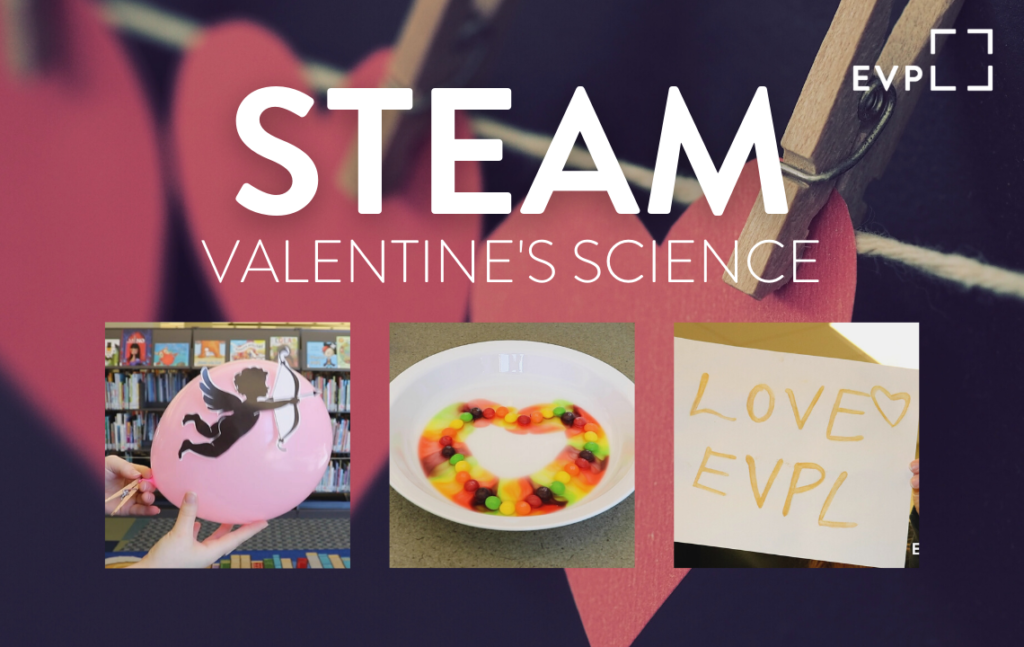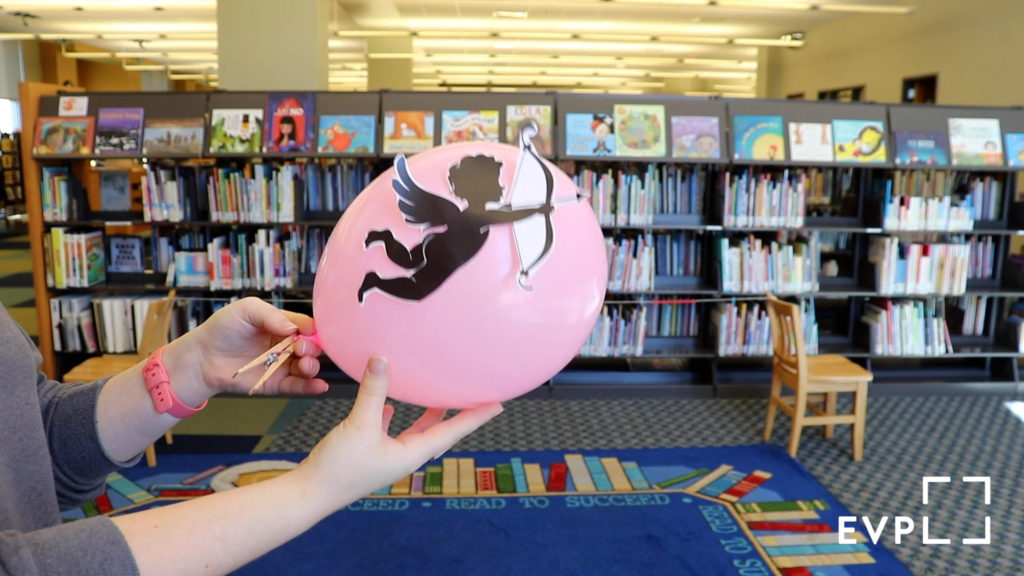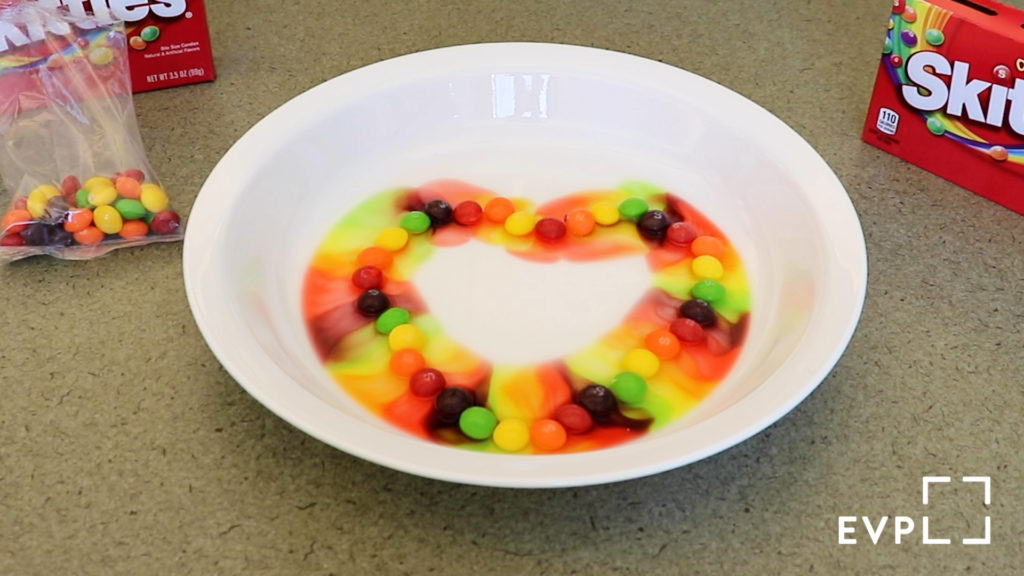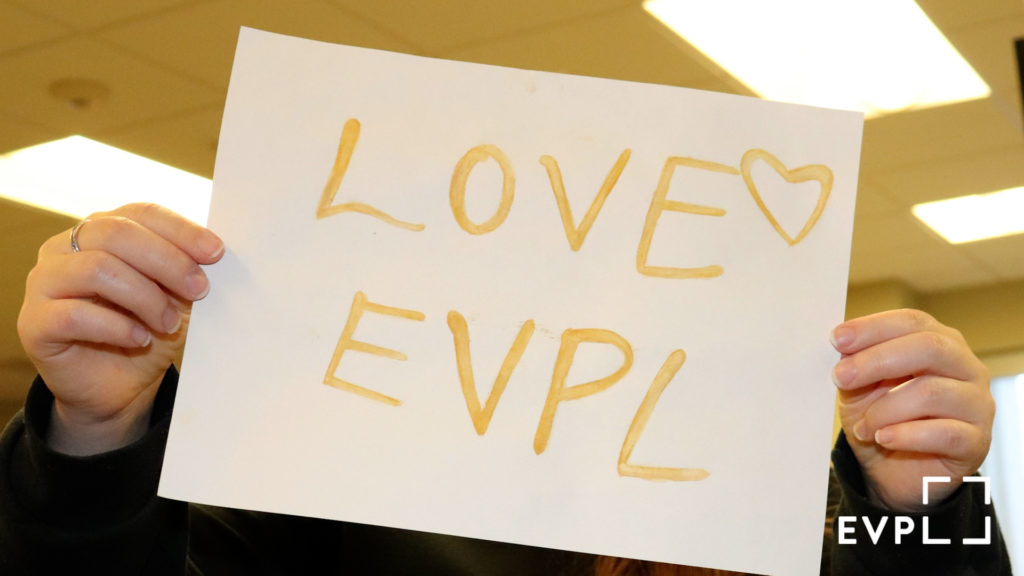Use your STEAM skills for fun Halloween experiments
Valentine’s Day is almost here, and it is the perfect time to explore your love of STEAM! These three holiday-themed experiments can be done using household items that are probably already in your cabinets. You can help Cupid send a valentine, try out candy art, and create invisible love notes. Try these five-minute science experiments at home and share your results with us! Be sure to talk together about the science behind the experiment and how yours was different from our example videos. Look at our questions to ask to keep the conversation going and get ideas for how to experiment further.
Check out our STEAM playlist on the EVPL YouTube channel for even more experiments to try together.

Cupid Balloon Rocket

- To start, you will need two anchor points across from each other. They can be anywhere from three to ten feet apart. If you can’t find anything, try using the backs of two chairs.
- Measure and cut your string to be the distance between your two anchor points. Tie one end to your chair, or another anchor object.
- Lace the free end of your string through the middle of a straw. Then pull the string tightly and tie it to your other anchor point. Your string should be taught and not dip down in the middle.
- Draw or print out and cut your picture of Cupid. You could also draw Cupid directly onto the balloon with a marker after the next step.
- Blow up your balloon, but do not tie it closed. Just pinch the end together with your fingers or a clothespin. While still pinching it, tape the balloon to the underside of the straw.
- When you are ready, let go and watch Cupid fly!
How It Works
Your Cupid rocket uses the same forces that real rockets use to fly into space! When the air flows out of the balloon, it creates a forward motion. This force is called thrust. Thrust is a pushing force that requires energy. The air rushing out of the balloon is exerting a force on the balloon itself, propelling it forward. In a real rocket, thrust comes from the force made by the burning rocket fuel.
Questions to Ask
- Does the amount of air in the balloon affect how far it goes? Try blowing the balloon up halfway to see the difference.
- Does the length of the straw affect the speed or distance? Cut your straw in half and see what happens.
- Does the angle of the string affect how fast the balloon can go? Tie the string to two things that are different heights and repeat the experiment!
Dissolving Skittles Art

- Open your Skittles, and place them onto a plain white plate or bowl. Form a pattern you like with the colors.
- Using your pattern, place the Skittles in the middle of the plate in a heart shape.
- Pour warm water onto the middle of the plate. You will need enough water to go past the Skittles and barely cover them. Be sure to pour the water very slowly so you don’t move the Skittles!
- Wait and watch the colors creep to the middle of the plate to form your own beautiful rainbow.
- Repeat the experiment for a new pattern or eat the leftover Skittles!
How It Works
Skittles are made of ingredients that dissolve (go from solid to liquid) in water. The outside coating of the Skittle dissolves quickly, and the food coloring gives each Skittle a different color. Each Skittle has about the same amount of coating so they dissolve at almost the same time and the colors don’t mix together much. The sugar and color move toward the center to areas of lower concentration until all areas are even. How many different designs can you create with your experiment?
Questions to Ask
- What happens if the water is at a different temperature? Try using ice cold water, and see if the experiment still works.
- Will this work with other candies? Try things like M&M’s, conversation hearts, or gummy bears.
- What would happen if you used a different liquid? Will this still work with milk or juice? How about vinegar or cooking oil? Try them all to find out!
Secret Valentine’s Message

- Cut a lemon or lime in half. Squeeze out the juice carefully into a bowl and stir.
- Dip your paintbrush or a cotton swab into the juice, and soak it well. Then, write your secret Valentine’s message on a piece of white paper.
- Leave your paper to dry for a few minutes. Your message should have totally disappeared.
- Give your message to someone special to be revealed! You need heat for your message to appear. You can use a hairdryer underneath the paper or place it in a warm oven for a few minutes with adult help. Can you read your message?
How It Works
The lemon juice you’re using to write your message contains carbon. Carbon is an element on the periodic table that is found all around us. In fact, carbon is in all living things. The carbon-based compounds in your lemon juice are colorless at room temperature. When you add heat, these compounds begin to break down. The carbon then comes into contact with the air and oxidizes, or reacts with the oxygen. This causes the compound to change color! This same reaction happens when you leave a cut banana or apple on the table for a while.
Questions to Ask
- Does lemon or lime juice work best? Try using both to find out. What happens if you make your solution weaker by adding water?
- Will other liquids work to write secret messages? Try using different things you have at home like milk, juice, or vinegar.
- Will cold work the same as heat to reveal your message? Try putting your paper in the freezer for a few minutes to find out.

Audra D.
With 8 locations throughout Vanderburgh County, EVPL is ready to discover, explore, and connect WITH you! We encourage you to uncover new things, revisit old favorites, and to engage with us along the way.
200 SE Martin Luther King Jr. Blvd
Evansville, Indiana 47713
Administration: ceo@evpl.org
Card & Account: circulation@evpl.org
Feedback & Ideas: marketing@evpl.org



